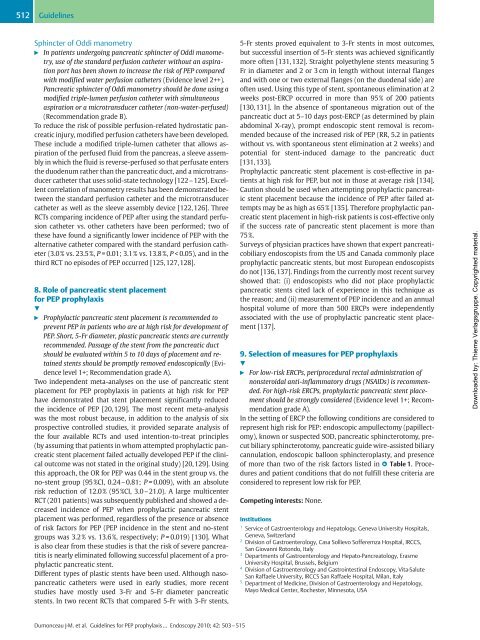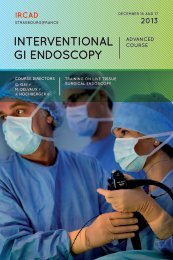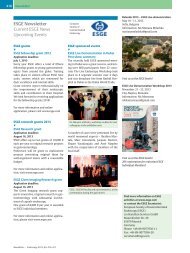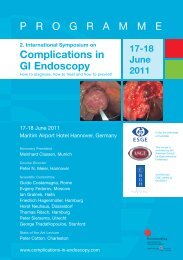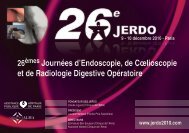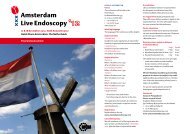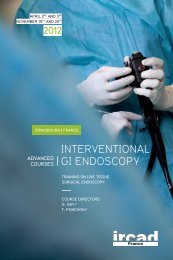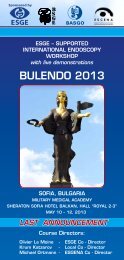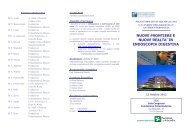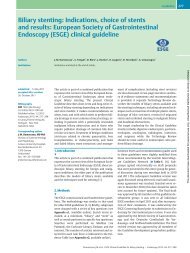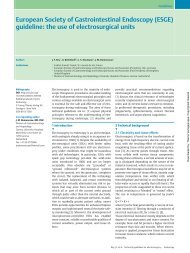(ESGE) Guideline: Prophylaxis of post-ERCP ... - ResearchGate
(ESGE) Guideline: Prophylaxis of post-ERCP ... - ResearchGate
(ESGE) Guideline: Prophylaxis of post-ERCP ... - ResearchGate
You also want an ePaper? Increase the reach of your titles
YUMPU automatically turns print PDFs into web optimized ePapers that Google loves.
512<br />
<strong>Guideline</strong>s<br />
Sphincter <strong>of</strong> Oddi manometry<br />
" In patients undergoing pancreatic sphincter <strong>of</strong> Oddi manometry,<br />
use <strong>of</strong> the standard perfusion catheter without an aspiration<br />
port has been shown to increase the risk <strong>of</strong> PEP compared<br />
with modified water perfusion catheters (Evidence level 2++).<br />
Pancreatic sphincter <strong>of</strong> Oddi manometry should be done using a<br />
modified triple-lumen perfusion catheter with simultaneous<br />
aspiration or a microtransducer catheter (non-water-perfused)<br />
(Recommendation grade B).<br />
To reduce the risk <strong>of</strong> possible perfusion-related hydrostatic pancreatic<br />
injury, modified perfusion catheters have been developed.<br />
These include a modified triple-lumen catheter that allows aspiration<br />
<strong>of</strong> the perfused fluid from the pancreas, a sleeve assembly<br />
in which the fluid is reverse-perfused so that perfusate enters<br />
the duodenum rather than the pancreatic duct, and a microtransducer<br />
catheter that uses solid-state technology [122 – 125]. Excellent<br />
correlation <strong>of</strong> manometry results has been demonstrated between<br />
the standard perfusion catheter and the microtransducer<br />
catheter as well as the sleeve assembly device [122, 126]. Three<br />
RCTs comparing incidence <strong>of</strong> PEP after using the standard perfusion<br />
catheter vs. other catheters have been performed; two <strong>of</strong><br />
these have found a significantly lower incidence <strong>of</strong> PEP with the<br />
alternative catheter compared with the standard perfusion catheter<br />
(3.0 % vs. 23.5%, P=0.01; 3.1% vs. 13.8 %, P < 0.05), and in the<br />
third RCT no episodes <strong>of</strong> PEP occurred [125, 127,128].<br />
8. Role <strong>of</strong> pancreatic stent placement<br />
for PEP prophylaxis<br />
!<br />
" Prophylactic pancreatic stent placement is recommended to<br />
prevent PEP in patients who are at high risk for development <strong>of</strong><br />
PEP. Short, 5-Fr diameter, plastic pancreatic stents are currently<br />
recommended. Passage <strong>of</strong> the stent from the pancreatic duct<br />
should be evaluated within 5 to 10 days <strong>of</strong> placement and retained<br />
stents should be promptly removed endoscopically (Evidence<br />
level 1+; Recommendation grade A).<br />
Two independent meta-analyses on the use <strong>of</strong> pancreatic stent<br />
placement for PEP prophylaxis in patients at high risk for PEP<br />
have demonstrated that stent placement significantly reduced<br />
the incidence <strong>of</strong> PEP [20, 129]. The most recent meta-analysis<br />
was the most robust because, in addition to the analysis <strong>of</strong> six<br />
prospective controlled studies, it provided separate analysis <strong>of</strong><br />
the four available RCTs and used intention-to-treat principles<br />
(by assuming that patients in whom attempted prophylactic pancreatic<br />
stent placement failed actually developed PEP if the clinical<br />
outcome was not stated in the original study) [20, 129]. Using<br />
this approach, the OR for PEP was 0.44 in the stent group vs. the<br />
no-stent group (95 %CI, 0.24 – 0.81; P=0.009), with an absolute<br />
risk reduction <strong>of</strong> 12.0 % (95 %CI, 3.0 – 21.0). A large multicenter<br />
RCT (201 patients) was subsequently published and showed a decreased<br />
incidence <strong>of</strong> PEP when prophylactic pancreatic stent<br />
placement was performed, regardless <strong>of</strong> the presence or absence<br />
<strong>of</strong> risk factors for PEP (PEP incidence in the stent and no-stent<br />
groups was 3.2 % vs. 13.6 %, respectively; P=0.019) [130]. What<br />
is also clear from these studies is that the risk <strong>of</strong> severe pancreatitis<br />
is nearly eliminated following successful placement <strong>of</strong> a prophylactic<br />
pancreatic stent.<br />
Different types <strong>of</strong> plastic stents have been used. Although nasopancreatic<br />
catheters were used in early studies, more recent<br />
studies have mostly used 3-Fr and 5-Fr diameter pancreatic<br />
stents. In two recent RCTs that compared 5-Fr with 3-Fr stents,<br />
Dumonceau J-M. et al. <strong>Guideline</strong>s for PEP prophylaxis … Endoscopy 2010; 42: 503 –515<br />
5-Fr stents proved equivalent to 3-Fr stents in most outcomes,<br />
but successful insertion <strong>of</strong> 5-Fr stents was achieved significantly<br />
more <strong>of</strong>ten [131, 132]. Straight polyethylene stents measuring 5<br />
Fr in diameter and 2 or 3 cm in length without internal flanges<br />
and with one or two external flanges (on the duodenal side) are<br />
<strong>of</strong>ten used. Using this type <strong>of</strong> stent, spontaneous elimination at 2<br />
weeks <strong>post</strong>-<strong>ERCP</strong> occurred in more than 95% <strong>of</strong> 200 patients<br />
[130, 131]. In the absence <strong>of</strong> spontaneous migration out <strong>of</strong> the<br />
pancreatic duct at 5–10 days <strong>post</strong>-<strong>ERCP</strong> (as determined by plain<br />
abdominal X-ray), prompt endoscopic stent removal is recommended<br />
because <strong>of</strong> the increased risk <strong>of</strong> PEP (RR, 5.2 in patients<br />
without vs. with spontaneous stent elimination at 2 weeks) and<br />
potential for stent-induced damage to the pancreatic duct<br />
[131, 133].<br />
Prophylactic pancreatic stent placement is cost-effective in patients<br />
at high risk for PEP, but not in those at average risk [134].<br />
Caution should be used when attempting prophylactic pancreatic<br />
stent placement because the incidence <strong>of</strong> PEP after failed attempts<br />
may be as high as 65% [135]. Therefore prophylactic pancreatic<br />
stent placement in high-risk patients is cost-effective only<br />
if the success rate <strong>of</strong> pancreatic stent placement is more than<br />
75%.<br />
Surveys <strong>of</strong> physician practices have shown that expert pancreaticobiliary<br />
endoscopists from the US and Canada commonly place<br />
prophylactic pancreatic stents, but most European endoscopists<br />
do not [136, 137]. Findings from the currently most recent survey<br />
showed that: (i) endoscopists who did not place prophylactic<br />
pancreatic stents cited lack <strong>of</strong> experience in this technique as<br />
the reason; and (ii) measurement <strong>of</strong> PEP incidence and an annual<br />
hospital volume <strong>of</strong> more than 500 <strong>ERCP</strong>s were independently<br />
associated with the use <strong>of</strong> prophylactic pancreatic stent placement<br />
[137].<br />
9. Selection <strong>of</strong> measures for PEP prophylaxis<br />
!<br />
" For low-risk <strong>ERCP</strong>s, periprocedural rectal administration <strong>of</strong><br />
nonsteroidal anti-inflammatory drugs (NSAIDs) is recommended.<br />
For high-risk <strong>ERCP</strong>s, prophylactic pancreatic stent placement<br />
should be strongly considered (Evidence level 1+; Recommendation<br />
grade A).<br />
In the setting <strong>of</strong> <strong>ERCP</strong> the following conditions are considered to<br />
represent high risk for PEP: endoscopic ampullectomy (papillectomy),<br />
known or suspected SOD, pancreatic sphincterotomy, precut<br />
biliary sphincterotomy, pancreatic guide wire-assisted biliary<br />
cannulation, endoscopic balloon sphincteroplasty, and presence<br />
<strong>of</strong> more than two <strong>of</strong> the risk factors listed in ● " Table 1. Procedures<br />
and patient conditions that do not fulfill these criteria are<br />
considered to represent low risk for PEP.<br />
Competing interests: None.<br />
Institutions<br />
1 Service <strong>of</strong> Gastroenterology and Hepatology, Geneva University Hospitals,<br />
Geneva, Switzerland<br />
2 Division <strong>of</strong> Gastroenterology, Casa Sollievo S<strong>of</strong>feremza Hospital, IRCCS,<br />
San Giovanni Rotondo, Italy<br />
3 Departments <strong>of</strong> Gastroenterology and Hepato-Pancreatology, Erasme<br />
University Hospital, Brussels, Belgium<br />
4 Division <strong>of</strong> Gastroenterology and Gastrointestinal Endoscopy, Vita-Salute<br />
San Raffaele University, IRCCS San Raffaele Hospital, Milan, Italy<br />
5 Department <strong>of</strong> Medicine, Division <strong>of</strong> Gastroenterology and Hepatology,<br />
Mayo Medical Center, Rochester, Minnesota, USA<br />
Downloaded by: Thieme Verlagsgruppe. Copyrighted material.


